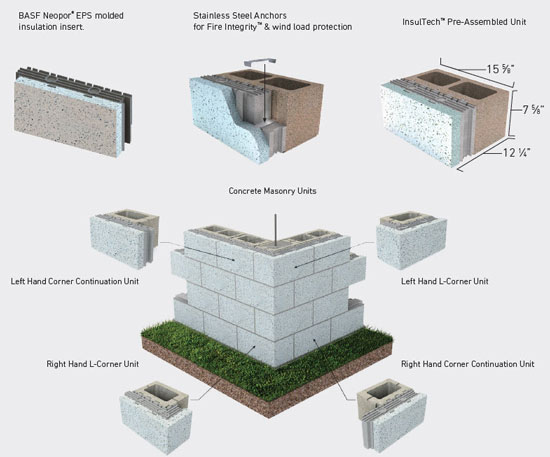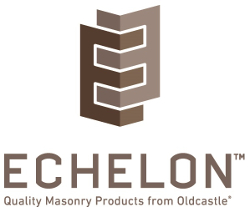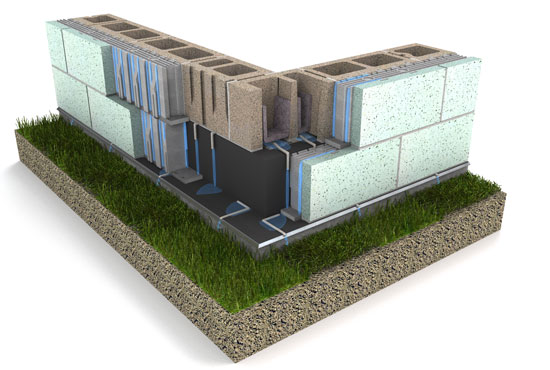Controlling Moisture in Masonry
Complete Masonry Systems
Manufacturers are continually developing innovative solutions that provide architects with increased performance and aesthetic benefits coupled with ease and efficiency of installation. A systems approach that incorporates several elements is increasingly being adopted in the construction industry as these products offer considerable efficiencies as well as installation advantages and cost savings. Manufacturers are now offering complete high-performance masonry systems that mitigate water penetration using water admixtures in block and mortar, and provide backup moisture management.
Two such systems involve different approaches. The first approach, an insulated concrete masonry system (ICMS), is comprised of a pre-assembled structural masonry unit (CMU), molded expanded polystyrene (EPS) insulation insert and thin veneer face; it is installed as a complete assembly and is fully thermally broken. Some ICMS utilize proprietary EPS foam insulation material, which has be shown to be the best performer among rigid foams in retaining the least amount of moisture—a situation that favorably impacts thermal performance. In terms of moisture management, some closed-cell foams like EPS have a Class III Vapor Permeability rating of between 2.5 and 5.5 perms depending on thickness and density, meaning that this type of continuous insulation can more easily transport water vapor, reducing the likelihood of mold, mildew, and structural damage. Architects should investigate the water absorption rate of the material relative to traditional insulation materials. ICMS with stainless steel ties offers protection in various extreme situations. Because they do not readily corrode, rust, or stain with water as do ordinary steel anchors, stainless steel anchors can be effective in salt water or coastal environments. Another moisture protection advantage in these systems is the fact that horizontal gaskets have drainage holes to channel water down and away from the building, which is particularly useful as the building ages and water infiltrates cracks in the mortar.
“This type of insulation provides the designer with flexibility as it is adaptable in size, shape, and density, which eliminates the need to glue together multiple boards to achieve the desired insulation thickness—a characteristic that enables designers to achieve R-value targets in a thickness-constrained application,” says John Cicciarelli, National Sales Manager at Oldcastle. “As codes evolve and R-value targets become ever more stringent, ICMS perhaps offer the best chance of easily adapting as a slight increase in insulation thickness can provide the necessary thermal performance.”

Photo courtesy of Oldcastle® Architectural
Drainage channels built in to both sides of the foam panel control moisture by allowing it to drain down and away from the structure.
Another option is a foam panel system. Relatively new to the market, foam masonry panel systems provide continuous insulation (CI), which is important because whenever a layer of insulation is interrupted, its effective R-value is reduced. These systems consist of foam panels, stainless steel screws or anchors, masonry units, and mortar. Moisture management is built into the foam system as drainage channels on both sides of the panel divert any moisture that has penetrated the wall channel downward and away from the structure so there is no build-up of water within the panel system. While achieving integrated moisture management, these systems also attain R-value targets that create energy savings and reduce heating and cooling costs with minimum thickness. The layer of continuous insulation outside the framing yields R-values as high as R-13. Foam systems pay substantial dividends in other areas as well. They have been proven to resist wind speeds of more than 110 mph and, placed beneath the masonry surface, foam panels give the wall system an STC rating of 51. This is especially desirable in multifamily structures because loud sounds will only be faintly heard, leaving occupants with a quiet dwelling. In rigorous testing per NFPA 285 and ASTM E119 standards, these systems have withstood hour-long exposure to temperatures exceeding 1,700 degrees Fahrenheit.
One critical area where both of these systems have an advantage is installation. Proper installation is vital to the effective functioning of any wall assembly, and installing wall assemblies with numerous elements can be time-consuming, costly, and prone to error. As a single-pass installation, these all-in-one products simplify the process, eliminating the need for adding insulation, moisture management, and finishing materials—saving associated labor costs and improving accuracy.
Sealing After Completion – The 110 Percent Solution
While integral water-repellent masonry block and mortar will protect a building against water intrusion, application of a custom masonry sealer will provide an extra measure of security. One successful approach is to use a clear, solvent-based silicone elastomer formulated to weatherproof custom masonry units and related materials. However, once silicone is applied, many other products will not adhere. This type of product will penetrate and fill any pores to prevent water infiltration through exterior walls exposed to normal weathering. Architects should look to specify a sealer with UV stability and protection against graffiti, as treated surfaces are able to resist many types of graffiti and to facilitate graffiti removal. The most effective sealers will also control surface stains such as efflorescence and mildew while not trapping moisture and allowing the surface to “breathe.” The selected product should also demonstrate good surface beading.
It is important, however, to test the sealer because not all products are compatible with surface treatments that have already been applied. The appearance and wetting characteristics of surfaces intended for the sealer should be noted, and previously applied surface treatments removed. The sealer can be applied by low-pressure fan spray or by brushes or rollers made of a synthetic material. The sealer manufacturer should be consulted in the event of any questions or issues that arise.
A System Approach to Controlling Moisture in Masonry
Significant moisture intrusion on a building will have adverse structural, aesthetic, and health impacts, and it can be devastating in terms of legal and financial consequences. While all buildings leak to some extent, moisture intrusion can be controlled by the appropriate design details and in the case of masonry construction, through water-repellent admixtures within the block and the mortar. Further, new high-performance systems with such admixtures offer superior moisture management capabilities while delivering energy efficiency and ease of installation and maintenance. For added protection, a custom masonry sealer coat can be added for a “110 percent” solution.

|
Echelon is the consolidated brand for all masonry products and services of Oldcastle Architectural including Trenwyth® Architectural Masonry, Artisan Masonry Stone Veneers®, Quik-Brik® Concrete Masonry Units, Amerimix® Bagged Goods and a complete portfolio of Performance Upgrades. As a single source masonry portfolio solution, Echelon delivers consistent, reliable product manufactured locally at more than 170 locations and delivered by an unrivaled logistics network. For more information, call (844) 495-8211 or visit EchelonMasonry.com |









